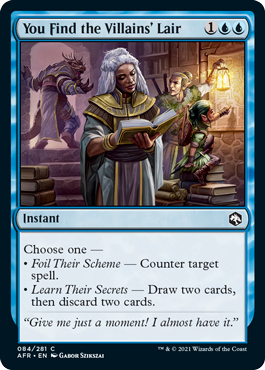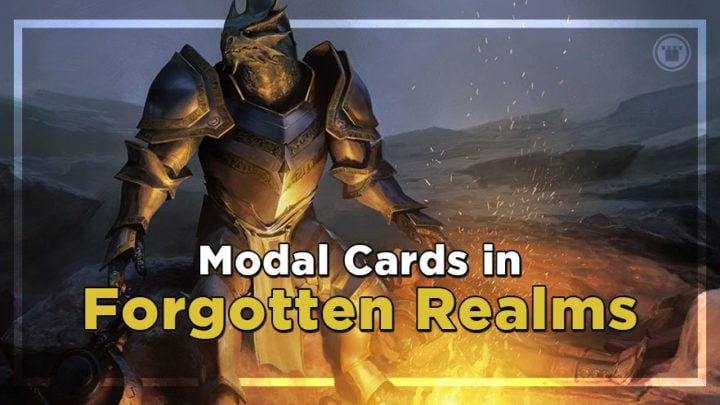It’s the end of preview season! We’ve ventured through the dungeons, rappelled down our Fifty Feet of Rope, and found the loot at the end. With just a couple short weeks remaining until its official release, now is the perfect time to take a look at one of the most fascinating aspects of Adventures in the Forgotten Realms: Modality!
Adventures in the Forgotten Realms has taken this year’s spot as the summer core set, but its increased complexity is a huge departure from the traditional design. Commons are reading more like uncommons, and uncommons like rares; however, the set’s power level still feels very reasonable. The main difference between this set and some of its predecessors is that a lot of the cards give players more options, and are better suited to a wider range of situations. Wizards have certainly been outputting more modal cards overall, particularly since the release of Arena, but this set stands out as one of the most decision-rich environments in recent years. Between cards with multiple choices, dice rolling cards, and the brand new Classes, the set is an intricate tapestry of unparalleled player agency.
My previous article on the subject will fill you in on the basics of identifying modal cards and how to evaluate them. I’m going to be talking about the overarching theme of modality in Adventures in the Forgotten Realms, so I’d recommend reading my previous article if this is new to you.
Why Modal Cards Are Good
I’m a big advocate for more modal cards in Magic. They make the game much more intricate and nuanced, and they’re flexible enough to adapt to new releases while keeping the power level stable. Cards that do more than one thing also tend to improve consistency and quality of gameplay, while simultaneously increasing the variety of potential game actions. Put simply: games tend to be smoother and more enjoyable, while still feeling like a unique experience every time.
The decision to include more choices on these cards was clearly done to fit the set’s D&D theme. Not only is this one of the best flavor designs I’ve ever seen, but such a massive injection of modal cards is going to be a huge benefit to the game as a whole. Let’s take a look at some of the new modal cards and how they will improve the gameplay experience.
Modal Cards in Commander

One of the biggest draws to Commander is how you can play with anything you like. If you have pet cards that are rotating out of Standard, they’ll fit into a deck somewhere. One of the biggest downsides to Commander, however, is you’re limited to just 99 cards! I’ve yet to meet a Commander player that hasn’t struggled to make the last few cuts in a deck; this is often down to an abundance of options, but it can also be a struggle to fit the right effects in. This is where modal spells can squeeze in that little bit more functionality.
Many players consider You Find the Villains’ Lair another “Cancel with upside,” but I believe this isn’t an accurate (or fair) deduction. A looting effect like this is extremely powerful and should probably be the main function of the card, particularly for proactive decks. Let’s say you’re playing a Reanimator deck: you want ways to put specific cards into the bin, and you probably have minimal slots available for interaction, especially any that’s reactive. You Find the Villains’ Lair is ideal for the role: not only is it a great way to set up your graveyard, but you also have the option of countering a spell without dedicating one of your slots to it. Similarly, if you run a cascade commander like Maelstrom Wanderer, there are very few options for counterspells available. They’re a terrible hit while cascading, and you really want to be as proactive as possible. You Find the Villains’ Lair could slot in nicely beside the likes of Sublime Epiphany and Mystic Confluence, to provide an extra dimension to what’s typically a very linear strategy.

Despite the high number of artifacts in the format, Shatter doesn’t see much play at all. It’s simply too narrow, and any deck with access to Disenchant or Nature’s Claim will usually choose to play them instead. I mentioned the usefulness of Shredded Sails in my previous article, but You Find Some Prisoners is like its chaotic neutral cousin. Sure, there will be situations when you don’t need a Shatter, but rather than cycle it for the next card in your deck, you can cycle it for one from an opponent’s deck. It could blow up that Aetherflux Reservoir and save the table, or steal a win condition! Cards like this introduce the potential for wild scenarios and one-in-a-million moments, without reducing the functionality of your deck. The more cards like this you add to your lists, the more memorable games you’re likely to have.
These are just two examples of how modal cards can change the textures of game play across many different decks in Commander. Looking further towards more competitively focused formats, modal cards can influence deck construction and in-game choices in completely different ways.
Modal Cards in Modern
There have always been countless modal cards that see a lot of play in the Modern format. Some of them could be considered the posterchildren for Modern: Cryptic Command, Abrade, and Archmage’s Charm, to name a few. While the new cards in Adventures in the Forgotten Realms may not belong on the same pedestal as those cards, there are many that could have a great impact. One such example of this is You Find a Cursed Idol.

This initially reads as a worse Naturalize thanks to its sorcery speed, and in most cases, that’s an accurate analysis. The reason I bring up this card is because of the delicate nuance of sideboard construction in Modern. Fifteen cards is not a lot of space to be able to account for the dozens of archetypes you could face; therefore, sideboarding becomes one of the most crucial skills in the format. To illustrate my point, I’ll use some green sideboard cards: Wilt, Nature’s Claim, and Foundation Breaker.

Most sideboards include artifact and enchantment hate, as it can deal with a wide range of problems (particularly opposing hate pieces like Damping Sphere or Rest in Peace). When you look at the options available, they’re all subtly different: Wilt can be cycled, Nature’s Claim is efficient but comes with a downside, and Foundation Breaker is a creature. It’s crucial that you choose the one that synergizes with your deck the most. Wilt is best in decks that may need to cycle it later on in the game, like Golgari Food; it replaces itself when not needed, and enables you to cast Asmoranomardicadaistinaculdacar. Nature’s Claim often sees play in decks like Tron and Infect; they don’t care about the opponent’s life total all that much, so there’s no real downside for them. In fact, Tron can also target their own artifacts to gain life against Burn! Meanwhile, Foundation Breaker is showing up in Living End decks now; it’s a creature that can destroy hate like Leyline of the Void while also going straight to the graveyard to be brought back later.
You Find a Cursed Idol is a unique interpretation of the classic Naturalize formula: if you don’t need it for its primary purpose, you can use it to advance your game plan. The recent Sultai Game Objects decks could make great use of this spell; if you don’t need it to deal with a problem when you draw it, you can just use it to keep your token engine running instead! This additional modality gives your deck extra depth and consistency, and should be added to the list of cards to consider when choosing your sideboard slots.
There’s one more consideration when it comes to You Find a Cursed Idol, and venture cards in general: the inherent modality provided by dungeons.
Dungeons & Modality
Tom Anderson did a fantastic job of explaining how dungeons work in his recent Mechanic Spotlight article, so you can check that out if you want a quick refresher on them.

There are three dungeons in AFR, each of which provides different outcomes. This already means that any card with the venture mechanic is by definition a modal spell, as you have three options to choose from the first time you use it. You are priced into completing a dungeon once you start it, but every dungeon has at least one point where you have a choice between rooms. In addition, your venture cards won’t always do the same thing in every game. You have a good idea what they will do, but the dungeon you’ve chosen and the number of times you’ve ventured already will alter the outcomes. These are great examples of modality helping to maintain a player’s feeling of agency while livening up the game experience.
There’s a unique feeling of universal benefit from dungeons, too. In casual games, most of the dungeon options won’t shift the advantage bar all that much. As there is no real downside to most of the choices, players should feel satisfied from navigating these scenarios with increased complexity without feeling overwhelmed, and the “feel bads” will be kept to a minimum. For competitive players, the micro-decisions are often what turn the tide of battle. Taking the wrong door in a dungeon could spell doom; in order to come out the other side as a successful adventurer, players will now have to think several turns ahead. This places a greater emphasis on every choice made in-game, rewarding players for planning appropriately. When this pays off, the feeling of satisfaction will be sublime.
***
Ultimately, agency is crucial in cultivating the best gaming experience possible. Modal cards are essential for this, providing players with the necessary tools to adapt to each game. Whether you view them as a way to pack more fun into your decks, as the cornerstone of metagaming and sideboarding in competitive play, or just to make you feel good about your decisions, more options will always lead to more fun. Dungeons & Dragons: Adventures in the Forgotten Realms is packed full of incredible cards from common to mythic that will improve the overall experience, no matter what format or style you play. The only problem now is choosing what cuts to make to fit them in!
What’s your favorite modal card from this set? Do you have a pet modal card you add to your decks? I’d love to hear what you think over on Twitter!

Scott is an Irish content creator and the Head of Budget Magic for the Izzet League. He focuses on affordable decks in Pioneer, Modern, and Pauper, particularly ones that stray from the mainstream. When he’s not writing about his favorite decks, he can be found talking incessantly about them on Twitter and on The Budget Magic Cast.

